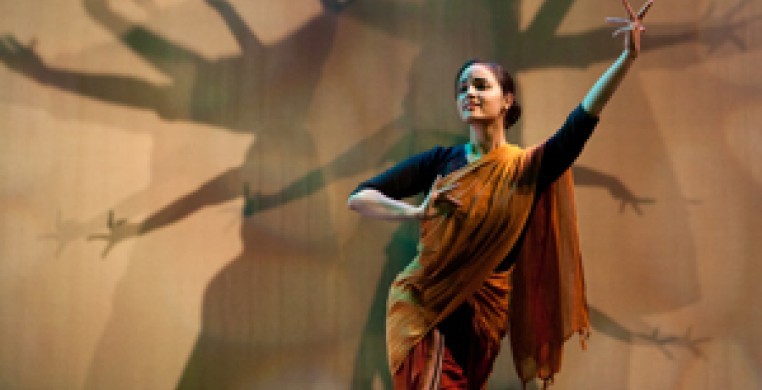Rhythm is at the heart of Natya Dance Theatre’s adaptation of “The Flowering Tree,” which had its premiere performance this past Sunday at Skokie’s North Shore Center for the Performing Arts. From the first lyrical chanting and engaging narration of Sutradhara, the Storyteller (Krithika Rajagopalan), to the story’s impassioned denouement, it is rhythm that delineates characters and builds the drama that shapes their lives, their relationships, and the emotions that activate their story.
“The Flowering Tree” is based on a folk tale from the South Indian state of Karnataka. It tells a story about how we should treat each other and respect nature. When a poor peasant girl, Kumudha (Shobhana Gopalakrishnan), is ridiculed by the rich girls of her village, a voice gives her the secret of a magic spell that enables her to turn into a flowering tree and back again to her human form. In a Cindarella-like turn of events, this leads to her marriage to the prince (Vinay Srinivasan). When he and his jealous sister (Leena B. Mithal), misuse Kumudha’s gift, she loses her cherished independence. She and the tree are nearly lost forever, but “nature is forgiving.” The prince and his sister recognize their transgression and ask Kumudha and the gods for forgiveness. Through the transformative power of repentance both Kumudha and the tree are restored.
One of several fascinating and original aspects of this charming production are the many different and surprising sources of rhythm in the storytelling. There is a musical lilt to the language of the Storyteller’s text, translated from the original Kannada by the late poet and scholar A.K. Ramanujan and adapted by Krithika Rajagopalan.
The story itself embodies a rhythmic symmetry of stasis to upheaval to stasis, reflected in the dancers’ every gesture, from the detailed nuances of head inclinations, facial expressions, and finger and hand positions, to the intricate rhythm-making of bare feet and the sweeping grand thrust of full group movement across the stage.
Natya Dance Theatre is one of the leading exemplars of Bharata Natyam, an ancient Indian dance form which unites the expressiveness of the human body with the melody of the human voice and the rhythmic complexities of classical Indian music to convey story.
The choreography for “The Flowering Tree,” by Natya artistic director Hema Rajagopalan and her daughter, Krithika Rajagopalan, transmits this tradition with striking fidelity and execution, while at the same time infusing the work with subtle contemporary western theatrical conventions that make the dance drama more accessible to modern American audiences.
Attention to story clarity is especially effective in the use of the Storyteller/narrator who seamlessly steps into character to assume an occasional role.
Of particular note is the wonderful use of spatial group patterns and exciting movement invention in the chorus, such as off-center lunges, pointed focus of knees and elbows to propel energy, level changes in low squats and high kicks. Group movement adds visual interest and rhythmic texture to the stage picture and story action in counterpoint to solo movement. Much like the Greek chorus in the plays of Aeschylus and Sophocles, the chorus takes on various roles, such as the village aristocracy, palace attendants, and passersby, but also provides a kind of kinesthetic commentary on story events and a physical amplification of individual characters’ emotional states. Delightful costumes, designed by Rex, provide the chorus with a rainbow of distinctive identities and keep the audience’s eye surprised and engaged.
In a magical touch of creativity, the choreographers have used the chorus’s combined bodies to construct a living, breathing tree, which appears mid-story and at its conclusion, creating both searing metaphor and stunning visual spectacle. The power and beauty of their movement delivers the message of the story, “you are the flowering tree,” with elegance and simplicity.
The same can be said of the dancing of this fine troupe, especially in the principal characters. Especially impressive are Gopalakrishnan’s compelling sincerity as the sympathetic Kumudha; Srinivasan, a dancer of lush lyricism and depth as the riveting prince; and Mithal as his deliciously self-absorbed sister.
The original score by Rajkumar Bharathi drives the action and charges the dancers’ characters with ever-changing rhythmic patterns that both reflect and propel their emotional journeys. His music, like the choreography, is faithful to traditional Indian melodies and rhythmic constructs through song, tabla, percussive vocal syllables, and sitar, while infusing the score with subtle western instrumentations and orchestral conventions, such as the use of saxophone in the prince’s solo.
Natya Dance Theatre seeks to achieve “rasa,” the transforming aesthetic experience at the center of the performing arts of India. In “The Flowering Tree” they have certainly done that!
